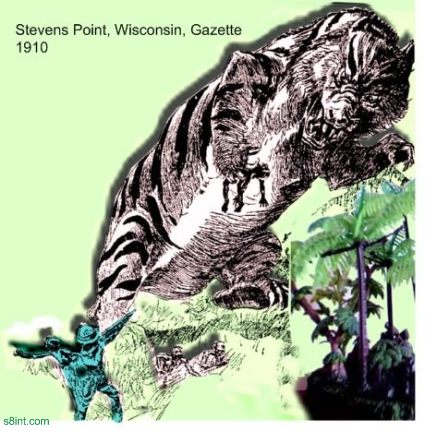My Own Special Encounter with Mr. Coleman, World Famous Cryptozoologist
This entire post is actually not about pterosaurs at all but about my Sherlock Holmes like identification of Monckton’s Gazeka.
Back in 2009 I wrote a “brilliant” post about the s8int.com identification of Monckton’s Gazeka, a problem/musytery that had mystified/intrigued zoologists, paleontologist and cryptozoologists since 1910 (Even Christian cryptozoologists).
See back in 1910 the Stephens Point, Wisconsin Gazette published a syndicated story about a giant, prehistoric appearing creature in the “wilds of New Guinea”.
According to the article, a prehistoric monster much larger than an elephant had been discovered and encountered not by common folks like me and you, but by scientists.
In addition, to the giant monster,the scientists had come across a “marvelous race of pigmies” who averaged just over four feet in height.
According to the article; the expedition was sent out by a committee appointed by the British Ornithologist’s union to explore the great Snow mountains in Dutch New Guinea, and consists of several famous scientists, headed by Walter Goodfellow, the naturalist.”
“According to the official reports, the Gazeka is of gigantic size and fearsome aspect. It is black and white striped, has the nose of a tapir and “a face like the devil.”
Among the English inhabitants of the island, the animal is known as Monckton’s Gazeka, in honor of Mr. C. A. W. Monckton, a former explorer In New Guinea, who first reported its presence in the mountains.
Mr. Monckton, during his ascent of Mount Albert Edward, in the west of British New Guinea, discovered the huge footprints and other indications of the very recent presence of some tremendous monster that had evidently been prowling on the grassy plains surrounding the lakes on the summit at an elevation of about 12,500 feet.
He followed the trail all day, and came upon the monster at dusk, just as it was devastating a settlement of the pigmies.
The little natives were screaming and running for their lives, although they turned every now and again to aim their poisoned arrows at the brute.
Monckton let fire as soon as he was able to get in a proper position, and the huge Gazeka at once turned upon him. As it reared upon its hind legs and pawed the air it looked to the hunter as big as a house, standing fully 25 feet high.
http://s8int.com/WordPress/2012/10/14/h ... ar-me-now/

This entire post is actually not about pterosaurs at all but about my Sherlock Holmes like identification of Monckton’s Gazeka.
Back in 2009 I wrote a “brilliant” post about the s8int.com identification of Monckton’s Gazeka, a problem/musytery that had mystified/intrigued zoologists, paleontologist and cryptozoologists since 1910 (Even Christian cryptozoologists).
See back in 1910 the Stephens Point, Wisconsin Gazette published a syndicated story about a giant, prehistoric appearing creature in the “wilds of New Guinea”.
According to the article, a prehistoric monster much larger than an elephant had been discovered and encountered not by common folks like me and you, but by scientists.
In addition, to the giant monster,the scientists had come across a “marvelous race of pigmies” who averaged just over four feet in height.
According to the article; the expedition was sent out by a committee appointed by the British Ornithologist’s union to explore the great Snow mountains in Dutch New Guinea, and consists of several famous scientists, headed by Walter Goodfellow, the naturalist.”
“According to the official reports, the Gazeka is of gigantic size and fearsome aspect. It is black and white striped, has the nose of a tapir and “a face like the devil.”
Among the English inhabitants of the island, the animal is known as Monckton’s Gazeka, in honor of Mr. C. A. W. Monckton, a former explorer In New Guinea, who first reported its presence in the mountains.
Mr. Monckton, during his ascent of Mount Albert Edward, in the west of British New Guinea, discovered the huge footprints and other indications of the very recent presence of some tremendous monster that had evidently been prowling on the grassy plains surrounding the lakes on the summit at an elevation of about 12,500 feet.
He followed the trail all day, and came upon the monster at dusk, just as it was devastating a settlement of the pigmies.
The little natives were screaming and running for their lives, although they turned every now and again to aim their poisoned arrows at the brute.
Monckton let fire as soon as he was able to get in a proper position, and the huge Gazeka at once turned upon him. As it reared upon its hind legs and pawed the air it looked to the hunter as big as a house, standing fully 25 feet high.
http://s8int.com/WordPress/2012/10/14/h ... ar-me-now/




